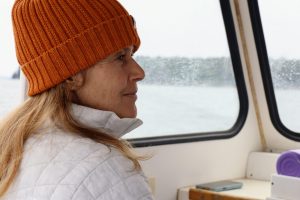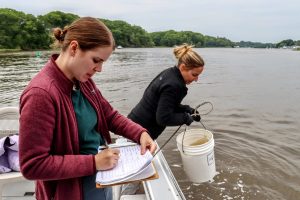If you were to swim in Casco Bay on a winter day, you would probably be thinking one thing: cold!
But for marine life, it’s a different story. Especially this winter.
Data from our Yarmouth Continuous Monitoring Station show Casco Bay is about 4°F warmer than the past seven winters, on average. This observation comes as scientists continue to report year-round temperatures in Casco Bay and the Gulf of Maine are rising faster than most other water bodies on the planet.

“While four degrees may not seem like much, this seemingly small change in temperature can kick off a cascade of changes throughout Casco Bay’s ecosystem,” says Staff Scientist Mike Doan. Green crabs provide a compelling example.
Originally from Europe, green crabs are estimated to have arrived in Maine around 1900 after hitching a ride on ships crossing the Atlantic Ocean. Their preference for feeding on shellfish like softshell clams became a clear problem in the 1950s, when an increase in water temperatures coincided with a boom in Maine’s green crab population. Softshell clam harvests plunged in those years. The fishery rebounded after colder water temperatures returned in the 1960s and the green crab population declined.
The connection between warmer water temperatures and more green crabs has been seen repeatedly in Maine. Scientists think this is partly because green crabs struggle to survive colder winters, but fare much better when water temperatures warm.

Green crab populations have surged many times in recent decades, often with devastating consequences for softshell clams and the Mainers who harvest them. In addition to predating on clams, green crabs also pose a threat to one of the most important lifeforms in Casco Bay: eelgrass.
Eelgrass is an ecologically vital, ribbon-like seagrass that grows underwater in the shallows of Casco Bay and Maine’s coast. Eelgrass meadows provide nursery habitat for many kinds of fish and shellfish, and help maintain water quality by absorbing nutrients and stabilizing sediments. Eelgrass meadows also help address climate change, as they are exceptionally good at absorbing and storing carbon dioxide.
When a green crab encounters eelgrass as it scuttles along the bottom of the Bay, it will often clip the grass at the base and continue to search the area for food. Juvenile crabs may feed on the base of the plant itself. This behavior is thought to be a major cause of eelgrass loss, where a 2012 – 2013 boom in green crab populations coincided with the loss of nearly fifty percent of the eelgrass in Casco Bay.
As we think about this winter’s warm water temperatures, green crabs, and their potential impacts, it is important to remember a common saying that any scientist will know: correlation does not imply causation. In a complex ecosystem like Casco Bay, there are many factors that influence the size of green crab populations. Temperature is only one of them.
“It would be misleading to say that we will certainly see more green crabs in the Bay this summer,” says Mike. “But with what we know from science and Maine’s history, it’s fair to say there is a good chance we will see more green crabs in the coming months.”


